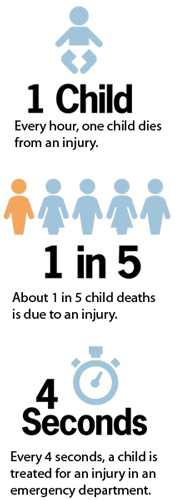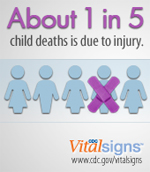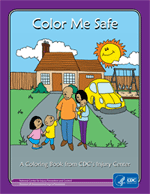National Action Plan for Child Injury Prevention: Protecting our Nation's Future
Download Print Version [441KB PDF]

Overview
Injury is the #1 killer of children and teens in the United States. In 2009, more than 9,000 youth age 0-19 died from unintentional injuries in the United States. Millions more children suffer injuries requiring treatment in the emergency department. Leading causes of child injury include motor vehicle crashes, suffocation, drowning, poisoning, fires, and falls.1 Child injury is predictable and preventable. It is also among the most under-recognized public health problems facing our country today.
Progress has been made in preventing child injury. Child injury death rates have decreased 29% in the last decade.2 Yet injury is still the leading cause of death for children and teens. More can be done to keep our children safe.
A National Action Plan
The Centers for Disease Control and Prevention (CDC) is committed to preventing child injury by supporting solutions that will save lives and help children live to their fullest potential. The National Action Plan for Child Injury Prevention was developed by CDC and more than 60 stakeholders to spark action across the nation. The National Action Plan’s overall goals are to:
- Raise awareness about the problem of child injury and the effects on our nation.
- Highlight prevention solutions by uniting stakeholders around a common set of goals and strategies.
- Mobilize action on a national, coordinated effort to reduce child injury.
The Framework for Action
The National Action Plan is built around six domains that contain goals and actions based on what we know, where we need to go, and how we can get there—at the broadest level. Below are just a few applications of how the National Action Plan domains—and the goals therein—can inform concrete actions within the field of injury prevention to reduce child injury in the United States.
Data and Surveillance are crucial to help us understand who is affected by child injury, who is at risk, and how an injury affects a child’s health and quality of life. The National Action Plan calls for better standardizing of data, improving data quality, and filling gaps that will help inform prevention efforts.
For example: Expand and standardize child death reviews, so that their information can be incorporated into national, state and local decision-making about how to invest resources to address important child injury issues.
Research has helped us create and implement new, effective interventions to prevent child injury, such as bicycle helmets, pool fencing, smoke alarms, and graduated driver licensing systems. The National Action Plan recognizes the crucial role of research in understanding new hazards and in finding ways to increase use of proven strategies. It identifies the need for cross-discipline research and coordination at national and state levels.
For example: Develop a national child injury research agenda that outlines specific research needs for each major cause of injury. This agenda could guide federal and private sector funding opportunities and research fellowships to advance prevention.
- Motor vehicle crashes are the leading cause of injury death overall, and especially for teens.
- For infants, suffocation is the biggest risk of injury death.
- Drowning is the leading cause of injury death for children age 1-4.
- Fires, burns, and falls are other common causes for all age groups.
For example: Create national campaigns designed to deliver effective safety messages to children and their caregivers. Use these campaigns to address the leading causes of child injury and include coordinated messages delivered by various partner organizations.
Education and Training are important in teaching knowledge and skills to change behaviors and improve safety. The National Action Plan calls for better education for decision makers—including parents and those who work with children—about the importance of prevention.
For example: Improve training on injury prevention in schools of education, public health, medicine, nursing, allied health fields, law enforcement, and others. For instance, training on injury prevention for medical students and pediatric residents could be enhanced so that they provide injury prevention guidance to their patients.
 Health Systems and Health Care providers not only treat child injuries, but are important in preventing injuries from happening in the first place. The National Action Plan asks that health systems and health care providers become more actively involved in prevention.
Health Systems and Health Care providers not only treat child injuries, but are important in preventing injuries from happening in the first place. The National Action Plan asks that health systems and health care providers become more actively involved in prevention.
For example: Expand universal access to poison control centers, trauma systems, pre-hospital care, and preventive services. For instance, the scope and reach of emergency medical services could be expanded to improve service to rural residents and disadvantaged high-risk children.
Policy can prevent child injury on a large scale by changing systems and social norms. Policies that require child safety seat use, helmet use, and pool fencing have saved many lives. The National Action Plan calls for adoption and enforcement of these and other proven-effective policies as a critical part of protecting children.
For example: Evaluate current policies to understand their impact on preventing injuries and cost savings. For instance, Return-to-Play policies could be evaluated to determine their effectiveness in decreasing repeat head trauma among young athletes.
Moving Forward Together
CDC works with federal agencies, state and local health departments, nonprofit organizations, professional association, businesses, and research institutions to reduce the number of children that suffer preventable injuries.
Prioritizing child injury prevention is necessary for improving the health and well-being of children and teens in the United States. Preventing injuries also saves money. For example, every dollar spent on a booster seat saves society $71 dollars.3
Everyone—including parents, health care providers, educators, and community members—can take steps to prevent injury where they live, work, and play. We all have a part to play in the National Action Plan and in protecting our children—America's future.
References
- CDC. Web-based Injury Statistics Query and Reporting System [online]. National Center for Injury Prevention and Control, Centers for Disease Control and Prevention (producer). [2010 August 2].
- CDC. Vital Signs: Unintentional Injury Deaths Among Persons Aged 0–19 Years — United States, 2000–2009. MMWR; 2012;61: Early Release April 16, 2012.
- Children's Safety Network. 2010. Injury prevention: What works?—A summary of cost-outcome analysis for injury prevention programs (2010 Update). Washington, DC: Children's Safety Network Economics and Data Analysis Resource Center; 2010.
Get email updates
To receive email updates about this page, enter your email address:
Contact Us:
- Centers for Disease Control and Prevention
National Center for Injury Prevention and Control (NCIPC)
4770 Buford Hwy, NE
MS F-63
Atlanta, GA 30341-3717 - 800-CDC-INFO
(800-232-4636)
TTY: (888) 232-6348
New Hours of Operation:
8am-8pm ET/
Monday-Friday
Closed Holidays - cdcinfo@cdc.gov






